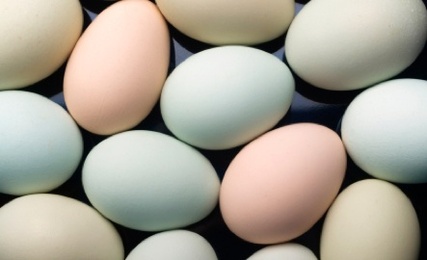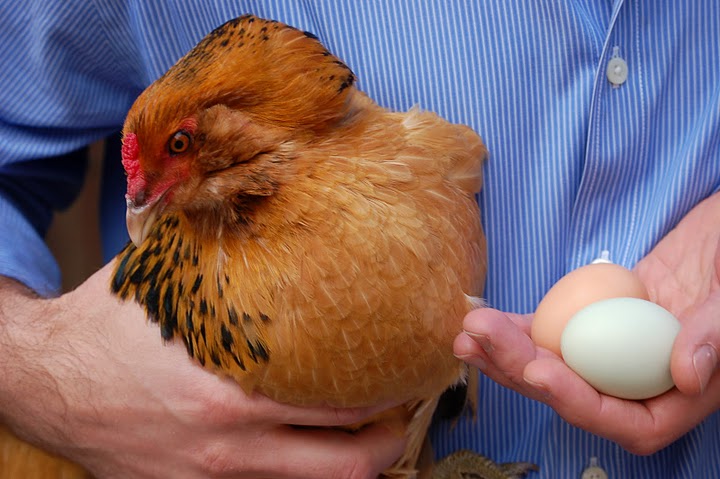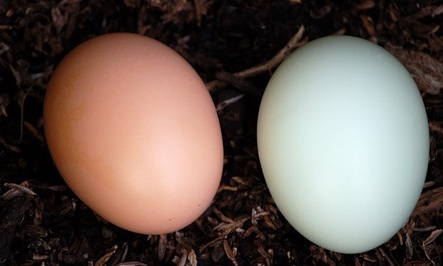Navigation
More options
You are using an out of date browser. It may not display this or other websites correctly.
You should upgrade or use an alternative browser.
You should upgrade or use an alternative browser.
Mayai ya blue
- Thread starter culboy
- Start date
Bujibuji Simba Nyamaume
JF-Expert Member
- Feb 4, 2009
- 74,871
- 155,834
Haya ni mayai ya bundi, wala sio ya kuku
M-pesa
JF-Expert Member
- Sep 4, 2011
- 602
- 151
Acha kudanganya watu, nimesoma articles nyingi za kutosha kuhusiana na mayai ya blue na hakuna uhusiano wowote na matibabu ya Kisukari. Uhusiano uliopo ni kati ya Specie ya kuku na rangi ya gamba la nje la yai, mambo mengine yote ni sawa na yai la kuku wa kawaida kabisa. Ukitaka maelezo zaidi tafadhali soma hapo chini
What About an Egg's Color?

get healthy living updates
The Cuckoo Maran hen lays deep cocoa-colored eggs, the Plymouth Rock lays pinkish ones, and the Ameraucana and Araucana lay a range from pale celadon to rich baby blue. Blue eggs are becoming increasingly available from both home hen-keepers as well as markets offering heirloom foods. For the pure visual pleasure I'd take a blue egg over a white one any day, but is there a nutritional difference in eggs with different colored shells?
Years ago, by pure chance, I learned about the secret stash of blue eggs that the dairy man stows away weekly at my local farmers market. You don't need a secret code word or a special handshake for him to slip you a dozen (I tried, he thought I was weird, oh well) but you do have to arrive early enough, before the "blue-egg lady" gets there and cleans him out. When I first got mine, they were so pretty I was reluctant to use them. I decanted them from their carton and put them in a bowl, center stage in the refrigerator, and just kind of marveled at them each time I opened the fridge.
When I finally cracked one open, my socks were officially knocked off by the intensity of the golden orange yolk. My first two thoughts, after, oh, man, pretty, were: Does it taste differently and is there a nutritional variable? At the very least, I couldn't fathom that a wan, insipid factory-farmed egg could possibly pack the same nutritional power as this vibrant heirloom number.

(Picture: Tiger, Care2 Founder and CEO Randy Paynter's Amerecauna, with one of her eggs, along with a brown egg from another hen.)
So. The blue egg. What a lovely thing, courtesy of the decidedly offbeat Ameraucana and Araucana hens. According to the Araucana Club of America, the club's namesake hen is a "challenging breed that combines the unusual traits of tufts, blue eggs and rumplessness." Circumstantial evidence suggests that the blue egg color came from crosses of chickens with pheasants. The first written evidence of the existence of blue eggs in Chile was in 1883, and by 1914 they were commonly found throughout South and Central America. As for the color of the shells, it only denotes the breed of the hen. Breeds with white feathers and ear lobes lay white eggs; breeds with red feathers and ear lobes lay brown eggs. (Who knew hens had earlobes?) And various other attributes are associated with hens who lay other-hued eggs.
I approached the first batch of blue eggs with my usual degree of food-geek curiosity–I opted for poaching, the method I knew would provide the purest means of discerning taste and texture. I was surprised that they weren't just exceedingly different from my usual eggs. They were slightly richer, but the difference wasn't astounding. Then again, I have been eating farm fresh eggs for a long time, so the standard by which I was measuring was pretty high. The one thing that was markedly different, though, was in how they cooked. The blue eggs, from my market at least, handle noticeably different in the pan. When poached, for instance, the yolk cooks more quickly than the white. Odd, but it gives a hint to the nutritional discrepancy.
In general, eggs are the standard by which other proteins are measured. Egg protein is said to be the highest quality food protein known, second only to mother's milk. Eggs provide 22 percent of an adult's daily requirement of choline, an essential nutrient for brain and memory functions, and egg yolk is one of the few foods that naturally contain vitamin D. Eggs offer carotene, calcium, iron, phosphorus, zinc, thiamin, B6, folate, B12 and pantothenic acid, to name just a few of their important nutrients. Although much of an egg's protein is contained in the white, its fat, cholesterol, and most of the other important nutrients come from the yolk. (And a note on cholesterol: an increasing body of scientific research is showing that the real offender in raising blood cholesterol levels is actually saturated fat in food, not cholesterol in food. In fact, the American Heart Association has changed its guidelines on eggs to say that there is no longer a specific recommendation on the number of egg yolks a person may consume in a week.)

(Eggs from Randy's backyard hens.)
In looking into the nutritional composite of blue eggs, I found numerous blogger references to increased protein and decreased cholesterol as compared to white eggs. But when I started to look at the more authoritative sources, like a study published by the U.S National Institute of Health, I discovered the opposite to be true. Comparative data collected over two years refuted the popular claims that blue-shelled eggs have higher protein levels and lower cholesterol levels than market eggs. And in fact, Araucana test groups were significantly lower in their total egg protein content than either control group, and were consistently higher in their cholesterol levels. While the differences are minimal enough to not really effect the overall nutritional potency, it is certainly interesting. (Well, to me at least. But then again, I have copies of Extraordinary Chickens and The Encyclopedia of Historic and Endangered Livestock and Poultry Breeds on my coffee table, so, you know…
Now about the color of the yolk. It turns out that the color of the yolk depends on the diet of the hen. A diet rich in yellow-orange plant pigments called xanthophylls, will result in a brighter yolk. The blander in color the diet is, the lighter the yolks will be. A hen fed white cornmeal produces almost colorless yolks. Marigold petals are often fed to hens to produce brighter eggs (artificial color additives are not permitted). Now I am sure that the yolks from the blue eggs are much brighter than the those from the brown eggs I get from the same vendor, whose hens have the same run of the same fields. Perhaps the Araucana hens, with their fancy tufts and eccentric eggs simply opt for the more exuberant forage–and doesn't that mean that those eggs have more phytonutrients than their paler counterparts? I don't know for sure, but those blue eggs look so pretty in my refrigerator that that's the story I'm going with for now.
What About an Egg's Color?
- Melissa Breyer
- April 2, 2010
- 3:24 pm
- 220 comments

get healthy living updates
The Cuckoo Maran hen lays deep cocoa-colored eggs, the Plymouth Rock lays pinkish ones, and the Ameraucana and Araucana lay a range from pale celadon to rich baby blue. Blue eggs are becoming increasingly available from both home hen-keepers as well as markets offering heirloom foods. For the pure visual pleasure I'd take a blue egg over a white one any day, but is there a nutritional difference in eggs with different colored shells?
Years ago, by pure chance, I learned about the secret stash of blue eggs that the dairy man stows away weekly at my local farmers market. You don't need a secret code word or a special handshake for him to slip you a dozen (I tried, he thought I was weird, oh well) but you do have to arrive early enough, before the "blue-egg lady" gets there and cleans him out. When I first got mine, they were so pretty I was reluctant to use them. I decanted them from their carton and put them in a bowl, center stage in the refrigerator, and just kind of marveled at them each time I opened the fridge.
When I finally cracked one open, my socks were officially knocked off by the intensity of the golden orange yolk. My first two thoughts, after, oh, man, pretty, were: Does it taste differently and is there a nutritional variable? At the very least, I couldn't fathom that a wan, insipid factory-farmed egg could possibly pack the same nutritional power as this vibrant heirloom number.

(Picture: Tiger, Care2 Founder and CEO Randy Paynter's Amerecauna, with one of her eggs, along with a brown egg from another hen.)
So. The blue egg. What a lovely thing, courtesy of the decidedly offbeat Ameraucana and Araucana hens. According to the Araucana Club of America, the club's namesake hen is a "challenging breed that combines the unusual traits of tufts, blue eggs and rumplessness." Circumstantial evidence suggests that the blue egg color came from crosses of chickens with pheasants. The first written evidence of the existence of blue eggs in Chile was in 1883, and by 1914 they were commonly found throughout South and Central America. As for the color of the shells, it only denotes the breed of the hen. Breeds with white feathers and ear lobes lay white eggs; breeds with red feathers and ear lobes lay brown eggs. (Who knew hens had earlobes?) And various other attributes are associated with hens who lay other-hued eggs.
I approached the first batch of blue eggs with my usual degree of food-geek curiosity–I opted for poaching, the method I knew would provide the purest means of discerning taste and texture. I was surprised that they weren't just exceedingly different from my usual eggs. They were slightly richer, but the difference wasn't astounding. Then again, I have been eating farm fresh eggs for a long time, so the standard by which I was measuring was pretty high. The one thing that was markedly different, though, was in how they cooked. The blue eggs, from my market at least, handle noticeably different in the pan. When poached, for instance, the yolk cooks more quickly than the white. Odd, but it gives a hint to the nutritional discrepancy.
In general, eggs are the standard by which other proteins are measured. Egg protein is said to be the highest quality food protein known, second only to mother's milk. Eggs provide 22 percent of an adult's daily requirement of choline, an essential nutrient for brain and memory functions, and egg yolk is one of the few foods that naturally contain vitamin D. Eggs offer carotene, calcium, iron, phosphorus, zinc, thiamin, B6, folate, B12 and pantothenic acid, to name just a few of their important nutrients. Although much of an egg's protein is contained in the white, its fat, cholesterol, and most of the other important nutrients come from the yolk. (And a note on cholesterol: an increasing body of scientific research is showing that the real offender in raising blood cholesterol levels is actually saturated fat in food, not cholesterol in food. In fact, the American Heart Association has changed its guidelines on eggs to say that there is no longer a specific recommendation on the number of egg yolks a person may consume in a week.)

(Eggs from Randy's backyard hens.)
In looking into the nutritional composite of blue eggs, I found numerous blogger references to increased protein and decreased cholesterol as compared to white eggs. But when I started to look at the more authoritative sources, like a study published by the U.S National Institute of Health, I discovered the opposite to be true. Comparative data collected over two years refuted the popular claims that blue-shelled eggs have higher protein levels and lower cholesterol levels than market eggs. And in fact, Araucana test groups were significantly lower in their total egg protein content than either control group, and were consistently higher in their cholesterol levels. While the differences are minimal enough to not really effect the overall nutritional potency, it is certainly interesting. (Well, to me at least. But then again, I have copies of Extraordinary Chickens and The Encyclopedia of Historic and Endangered Livestock and Poultry Breeds on my coffee table, so, you know…
Now about the color of the yolk. It turns out that the color of the yolk depends on the diet of the hen. A diet rich in yellow-orange plant pigments called xanthophylls, will result in a brighter yolk. The blander in color the diet is, the lighter the yolks will be. A hen fed white cornmeal produces almost colorless yolks. Marigold petals are often fed to hens to produce brighter eggs (artificial color additives are not permitted). Now I am sure that the yolks from the blue eggs are much brighter than the those from the brown eggs I get from the same vendor, whose hens have the same run of the same fields. Perhaps the Araucana hens, with their fancy tufts and eccentric eggs simply opt for the more exuberant forage–and doesn't that mean that those eggs have more phytonutrients than their paler counterparts? I don't know for sure, but those blue eggs look so pretty in my refrigerator that that's the story I'm going with for now.
Nauza mayai ya blue yanayotibu kisukari presha na magonjwa ya moyo pia mjasiriamali anatakaiwa kufuga hawa kuku mayai yake ni gali sana huuzwa mpk 5000/= number yangu ni 0757662401
Daudi Mchambuzi
JF-Expert Member
- Nov 25, 2010
- 62,204
- 128,020
Hao kuku umewatoa sayari gani??
Sent from my BlackBerry 9700 using JamiiForums
Sent from my BlackBerry 9700 using JamiiForums
Chimunguru
JF-Expert Member
- May 3, 2009
- 10,678
- 4,350
yALE YA kichina AU?
GP
JF-Expert Member
- Feb 5, 2009
- 2,049
- 160
Ni kweli, hata mie nmeyaona huku arusha wakati wa nane nane shows! Yaliuzwa hadi ssh 8000! Ni dawa nzuri ya hayo magonjwa yaliyotajwa.
mkuu sh. 8000 kwa yai MOJA au trei moja??
Fidel80
JF-Expert Member
- May 3, 2008
- 21,947
- 4,445
mayai yapo kweli tena yanauzwa ghali sana
Nani anataga hayo mayai?
KANCHI
JF-Expert Member
- Sep 3, 2011
- 1,533
- 230
Nani anataga hayo mayai?
Kuku jike aina ya mtetea.
Similar Discussions
-
-
Kipi kinakufanya utumie mayai ya kisasa na sio ya kienyeji?
- Started by ndege JOHN
- Replies: 18
-
Aina za kuku wa kufuga hapa Tanzania
- Started by Rugemarila Kassano
- Replies: 0
-
Uvimbe katika Mayai Ya Mwanamke (Ovarian Cyst)
- Started by Herbalist Dr MziziMkavu
- Replies: 1
-
Fugia kwenye vizimba (Cages), epuka hasara zisizo za lazima
- Started by Mwalimu interprises
- Replies: 2